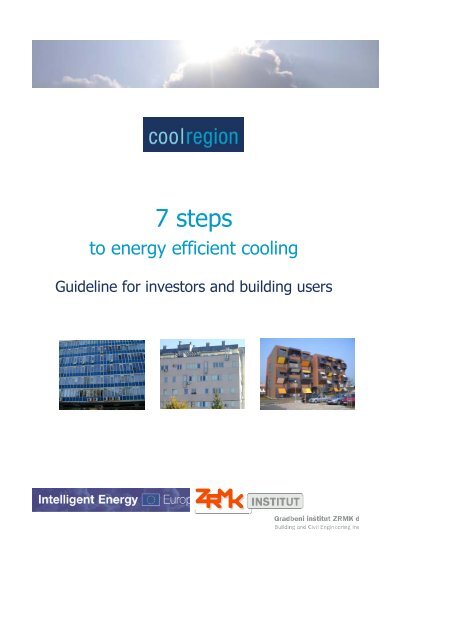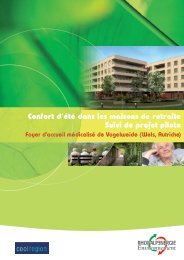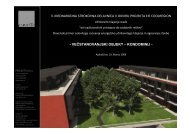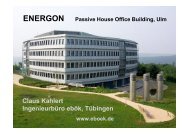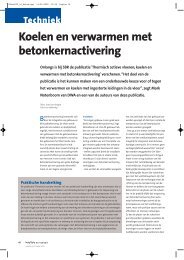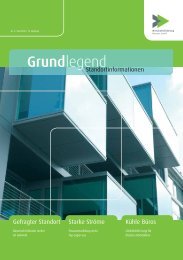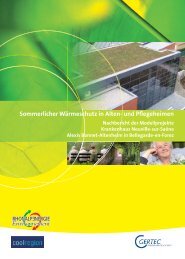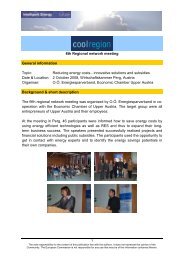D20 Building guideline Slovenia in English - coolregion
D20 Building guideline Slovenia in English - coolregion
D20 Building guideline Slovenia in English - coolregion
You also want an ePaper? Increase the reach of your titles
YUMPU automatically turns print PDFs into web optimized ePapers that Google loves.
7 steps<br />
to energy efficient cool<strong>in</strong>g<br />
Guidel<strong>in</strong>e for <strong>in</strong>vestors and build<strong>in</strong>g users
Introduction<br />
Energy Performance of <strong>Build<strong>in</strong>g</strong>s Directive (91/2002/EC) (EPBD) promotes the improvement of<br />
energy performance of build<strong>in</strong>gs <strong>in</strong> the Member States through the implementation of ambitious<br />
m<strong>in</strong>imum requirements, not only for heat<strong>in</strong>g but also for cool<strong>in</strong>g of build<strong>in</strong>gs. Cool<strong>in</strong>g of<br />
build<strong>in</strong>gs has <strong>in</strong> <strong>in</strong>creas<strong>in</strong>g impact on energy use. The ma<strong>in</strong> reasons are the climate change with<br />
extreme summer temperatures and grow<strong>in</strong>g users’ demands about the liv<strong>in</strong>g comfort.<br />
Furthermore, cool<strong>in</strong>g needs are <strong>in</strong>creas<strong>in</strong>g due to the architectural design which has <strong>in</strong> its quest<br />
for freedom, forgotten traditional pr<strong>in</strong>ciples and materials for bioclimatic build<strong>in</strong>g design <strong>in</strong> hot<br />
zones.<br />
Energy efficient cool<strong>in</strong>g of build<strong>in</strong>gs comprises m<strong>in</strong>imiz<strong>in</strong>g of cool<strong>in</strong>g loads by good architectural<br />
design, by the use of appropriate materials, by <strong>in</strong>tegrat<strong>in</strong>g passive cool<strong>in</strong>g solutions and<br />
efficient active cool<strong>in</strong>g systems for cover<strong>in</strong>g of the rema<strong>in</strong><strong>in</strong>g cool<strong>in</strong>g demand, where the use of<br />
renewables is strongly encouraged. These pr<strong>in</strong>ciples were first <strong>in</strong>troduced <strong>in</strong> non-residential<br />
sector, but recently they have found their way <strong>in</strong>to residential sector as well. Despite<br />
economical constra<strong>in</strong>ts imposed by <strong>in</strong>vestors on one hand, one can conclude that these holistic<br />
solutions are a must for a low energy and zero energy build<strong>in</strong>gs and for a high level of comfort<br />
requested by demand<strong>in</strong>g contemporary users.<br />
This <strong>guidel<strong>in</strong>e</strong> presents basic pr<strong>in</strong>ciples for energy efficient cool<strong>in</strong>g of residential and alike<br />
build<strong>in</strong>gs, presented <strong>in</strong> 7 steps.<br />
Urbanism<br />
<strong>Build<strong>in</strong>g</strong> and<br />
microlocation<br />
>>><br />
<strong>Build<strong>in</strong>g</strong><br />
envelope<br />
>>><br />
Shad<strong>in</strong>g<br />
Light<strong>in</strong>g<br />
Appliances<br />
Active<br />
cool<strong>in</strong>g<br />
>>><br />
>>><br />
>>><br />
>>><br />
Figure 1. Cool<strong>in</strong>g system is designed only after the implementation of cool<strong>in</strong>g energy sav<strong>in</strong>g<br />
potential due to good strategies <strong>in</strong> architectural design, selection of build<strong>in</strong>g components,<br />
reduc<strong>in</strong>g <strong>in</strong>ternal heat sources.<br />
1 Urbanism<br />
The first step <strong>in</strong> design of susta<strong>in</strong>able thermal comfort <strong>in</strong> w<strong>in</strong>ter and summer period of the year<br />
depends on the architect. When plann<strong>in</strong>g new areas the architect should note that the<br />
agglomerated urban areas represent the heat island, where the local temperatures are a few<br />
degrees higher than <strong>in</strong> their surround<strong>in</strong>gs.<br />
In the plann<strong>in</strong>g phase it is therefore necessary to avoid excessive heat mass <strong>in</strong> the vic<strong>in</strong>ity of<br />
build<strong>in</strong>gs, foresee evaporat<strong>in</strong>g surfaces <strong>in</strong> the urban environment, use appropriate materials <strong>in</strong><br />
the design of urban areas that reflect heat rather than absorb it and last but not least plan a<br />
sufficient amount of greenery and urban parks.<br />
Urbanism has to be planned <strong>in</strong> a way that it allows air flows for cross ventilation of the city as<br />
well as separation of districts with green zones.<br />
1
2 Microlocation<br />
What is relevant for energy efficiency <strong>in</strong> cool<strong>in</strong>g periods, when plann<strong>in</strong>g microlocation of the<br />
build<strong>in</strong>g The build<strong>in</strong>g concept as well as the user's profile can to m<strong>in</strong>imize the cool<strong>in</strong>g demand;<br />
however the microlocation of the build<strong>in</strong>g plays also an important role.<br />
When select<strong>in</strong>g the position of a build<strong>in</strong>g <strong>in</strong> the build<strong>in</strong>g plot, it is necessary to plan sufficient<br />
vegetation around the build<strong>in</strong>g, as these results <strong>in</strong> a cooler air <strong>in</strong> the surround<strong>in</strong>gs, better<br />
chance of the ambient to be cooled by evaporation of the water <strong>in</strong> the vegetation and care of a<br />
direct shad<strong>in</strong>g of facades. It makes sense to plan greenery <strong>in</strong> the form of green roof, as the<br />
build<strong>in</strong>g is be<strong>in</strong>g additionally cooled by evaporation of water and on the other hand vegetation<br />
prevents excessive absorption of solar radiation on the roof.<br />
Water <strong>in</strong> the vic<strong>in</strong>ity of a build<strong>in</strong>g cools surround<strong>in</strong>g air, so there are traditionally known<br />
solutions with founta<strong>in</strong>s, pools and water curta<strong>in</strong>s. Bright areas around the build<strong>in</strong>g prevent<br />
excessive heat<strong>in</strong>g of the surround<strong>in</strong>gs. If the build<strong>in</strong>g is orientated with its ma<strong>in</strong> side (side with<br />
w<strong>in</strong>dows) to south, as it makes shad<strong>in</strong>g easier and it is more consistent with the path of the<br />
sun. Complex facade allows local w<strong>in</strong>d turbulence and thus and additional cool<strong>in</strong>g effect.<br />
3 <strong>Build<strong>in</strong>g</strong> envelope<br />
The build<strong>in</strong>g envelope with adequate thermal characteristics can significantly reduce heat load<br />
from the environment. Heat storage capacity <strong>in</strong> the build<strong>in</strong>g envelope, shad<strong>in</strong>g of the<br />
transparent part of the envelope as well as reflection of excessive solar radiation are significant<br />
elements. <strong>Build<strong>in</strong>g</strong> physicists may prepare a detailed story for optimisation of heat flows <strong>in</strong> the<br />
build<strong>in</strong>g and its envelope.<br />
Heat storage capacity of a whole build<strong>in</strong>g and of its envelope should be designed. Thermal<br />
mass with<strong>in</strong> the build<strong>in</strong>g contributes to stabilised <strong>in</strong>ternal temperature, while the heat capacity<br />
of envelope reduces the daily maximum temperatures and reassures the proper reduction of<br />
temperature oscillation amplitude and guaranties the desirable time lag. In our climate it is<br />
sufficient if the thermal <strong>in</strong>sulation is placed on the outer side of the wall, so that the massive<br />
walls play a role of heat storage. In the case of lightweight structures, only the floor structures<br />
and partitions represent heat storage capacity. Heat storage surfaces areas should not be<br />
covered with carpets and other cover<strong>in</strong>gs or with excessive amount of furniture. It is<br />
recommendable to avoid double ceil<strong>in</strong>gs and double floors because additional layer h<strong>in</strong>ders<br />
accumulation of heat <strong>in</strong> the massive load bear<strong>in</strong>g structures.<br />
Thermal storage mass may also be planned as a part of a ground heat storage, rocks or water<br />
heat storage or as a part of the system for cool<strong>in</strong>g with activated concrete walls and roofs.<br />
An advanced solution for the <strong>in</strong>crease of heat storage capacity <strong>in</strong> the build<strong>in</strong>gs with light<br />
build<strong>in</strong>g envelope is to use phase-change materials (PCM), which melt at temperatures only<br />
slightly higher than the temperature of thermal comfort and absorb a latent heat <strong>in</strong> the critical<br />
periods of overheat<strong>in</strong>g of a build<strong>in</strong>g. Commonly used phase-change materials are encapsulated<br />
or <strong>in</strong>tegrated directly <strong>in</strong> the gypsum matrix used for prefabricated boards.<br />
The surfaces of the build<strong>in</strong>g envelope with a small albedo (white, reflective surface) ensure<br />
small absorption of solar radiation on the external surface of a build<strong>in</strong>g envelope, which is very<br />
important <strong>in</strong> the summer time. Good thermal <strong>in</strong>sulation of a build<strong>in</strong>g envelope additionally<br />
reduces conduction of heat from the exterior to the <strong>in</strong>terior of the build<strong>in</strong>g.<br />
W<strong>in</strong>dows are the major reason of summer overheat<strong>in</strong>g, as solar radiation enters through the<br />
glaz<strong>in</strong>g <strong>in</strong>to a room and there converts <strong>in</strong>to heat. It is important that the w<strong>in</strong>dows are equipped<br />
with shad<strong>in</strong>g devices, most common are bl<strong>in</strong>ds (advanced bl<strong>in</strong>ds have separate control of the<br />
lamellas <strong>in</strong> the area, which is <strong>in</strong>tended for daylight source). West-oriented w<strong>in</strong>dows <strong>in</strong> the<br />
sončno<br />
sevanje<br />
zračni tok<br />
T i<br />
konvekcija<br />
<strong>in</strong>filtracija<br />
zraka<br />
T e<br />
2
uild<strong>in</strong>g envelope are not very desirable, as they contribute to a rapid rise of temperature <strong>in</strong> the<br />
room. It is advisable to design a build<strong>in</strong>g <strong>in</strong> a way that work<strong>in</strong>g places are not exposed to high<br />
direct solar radiation.<br />
Good air tightness of a build<strong>in</strong>g envelope is necessary, as otherwise the cool<strong>in</strong>g system<br />
operates <strong>in</strong>efficiently, with high cold losses. W<strong>in</strong>dows should allow open<strong>in</strong>g, so that the benefits<br />
of natural ventilation and night cool<strong>in</strong>g of build<strong>in</strong>gs can be used, whenever <strong>in</strong>door air quality<br />
requirements allow so.<br />
4 Shad<strong>in</strong>g and daylight<br />
Shad<strong>in</strong>g of build<strong>in</strong>g is one of the most important steps <strong>in</strong> design of summer thermal comfort <strong>in</strong><br />
the build<strong>in</strong>g. External system of shad<strong>in</strong>g is far more effective than systems with <strong>in</strong>ternal bl<strong>in</strong>ds<br />
<strong>in</strong>side or with bl<strong>in</strong>ds between the glaz<strong>in</strong>g planes.<br />
If architecturally acceptable overhangs and other immovable shad<strong>in</strong>g devices are to be used.<br />
The comb<strong>in</strong>ation of fixed and movable bl<strong>in</strong>ds is usually preferred. Modern glaz<strong>in</strong>g technologies<br />
exhibit a wide range of optical properties, which are very important for optimized design of<br />
cool<strong>in</strong>g and dayligt<strong>in</strong>g. Advanced bl<strong>in</strong>ds allow separate control of the lamellas <strong>in</strong> the area, which<br />
is <strong>in</strong>tended for lett<strong>in</strong>g the daylight <strong>in</strong> the room.<br />
Glaz<strong>in</strong>g with high reflectivity may be acceptable sun protection, if at the same time the<br />
transmissivity for daylight is sufficiently high. Modern solutions of shad<strong>in</strong>g <strong>in</strong> low-energy<br />
build<strong>in</strong>gs are often comb<strong>in</strong>ed with photovoltaic panels. A very <strong>in</strong>terest<strong>in</strong>g architectural solution<br />
is the <strong>in</strong>tegration of transparent solar photovoltaic modules for shad<strong>in</strong>g, because <strong>in</strong> addition to<br />
provid<strong>in</strong>g shad<strong>in</strong>g and electricity they also admit enough daylight.<br />
The light<strong>in</strong>g design and sufficient cover<strong>in</strong>g of demand by daylight is important for the build<strong>in</strong>g<br />
efficient efficiency, as the need for electricity used for light<strong>in</strong>g is then smaller. Daylight can also<br />
be provided by light<strong>in</strong>g atriums or <strong>in</strong>directly by reflection of daylight from neighbour<strong>in</strong>g<br />
build<strong>in</strong>gs ether by prefabricated solar tubes.<br />
The design of artificial light<strong>in</strong>g is a good opportunity to reduce the electrical power for light<strong>in</strong>g<br />
by us<strong>in</strong>g energy efficient lamps. Sensors for the presence of people and the level of available<br />
illum<strong>in</strong>ation by daylight<strong>in</strong>g may reduce artificial light<strong>in</strong>g and thus contribute to energy sav<strong>in</strong>gs.<br />
5 Internal heat sources<br />
Electrical devices use energy for their operation and represent additional <strong>in</strong>ternal heat load.<br />
Various energy efficiency labels for appliances, which provide <strong>in</strong>formation about energy use of<br />
devices <strong>in</strong> operation (www.greenlabelspurchase.net), are helpful <strong>in</strong> reduc<strong>in</strong>g the heat load<br />
dur<strong>in</strong>g critical periods of overheat<strong>in</strong>g <strong>in</strong> the build<strong>in</strong>g. An important issue <strong>in</strong> this field is the user's<br />
attitude to rational use of energy; namely the appliances <strong>in</strong> a standby mode use energy <strong>in</strong> the<br />
amount equivalent to the cont<strong>in</strong>uosly operat<strong>in</strong>g traditional light bulb; therefore it is reasonable<br />
to use automated devices, which turn off all devices <strong>in</strong> standby mode.<br />
6 Passive cool<strong>in</strong>g<br />
<strong>Build<strong>in</strong>g</strong> can be cooled by night ventilation, when air temperatures <strong>in</strong> the environment are<br />
lower. The build<strong>in</strong>g fabric is thus cooled and as well as the diurnal room temperature gets<br />
reduced for some degrees. Night ventilation can be natural or mechanical. Natural ventilation of<br />
build<strong>in</strong>gs can be supported by solar chimney, where the warm air, heated by the sun,<br />
accelerates the natural convection of air through the build<strong>in</strong>g. An <strong>in</strong>teraction of a solar chimney<br />
3
very efficient <strong>in</strong> comb<strong>in</strong>ation with a ground heat storage for preheat<strong>in</strong>g/cool<strong>in</strong>g of air for<br />
ventilation. In general, the use of ground water as a cont<strong>in</strong>uous source of cold is a very<br />
economical source of cool<strong>in</strong>g for passive and active cool<strong>in</strong>g systems.<br />
One of the bioclimatic cool<strong>in</strong>g methods is also evaporative cool<strong>in</strong>g (e.g. water curta<strong>in</strong>s), known<br />
<strong>in</strong> the hot dry areas.<br />
7 Active cool<strong>in</strong>g<br />
In the Central and Southern Europe regions it is often impossible to fully satisfy the thermal<br />
comfort requirements with previous six steps only. This is especially valid for commercial<br />
build<strong>in</strong>gs, where large heat ga<strong>in</strong>s appear due to people and devices. In such build<strong>in</strong>gs<br />
(especially the older ones without tak<strong>in</strong>g care for the relevant measures) a need for cool<strong>in</strong>g is<br />
often present for half of a year or even more. In the case, where we need cool<strong>in</strong>g, it must be<br />
carried out as the most effecient way, m<strong>in</strong>imiz<strong>in</strong>g the use of secondary and primary energy. In<br />
do<strong>in</strong>g so, we meet with the contrast, s<strong>in</strong>ce such systems have higher <strong>in</strong>vestment costs.<br />
It is typical for cool<strong>in</strong>g systems that the ratio between the energy consumption and nom<strong>in</strong>al<br />
cool<strong>in</strong>g capacity power of devices is low. In residential build<strong>in</strong>gs, this is due to the low number<br />
of operat<strong>in</strong>g hours, and <strong>in</strong> commercial build<strong>in</strong>gs, this is due to the relatively low cool<strong>in</strong>g needs<br />
dur<strong>in</strong>g most of the cool<strong>in</strong>g season.<br />
Generally applicable measures and advices for the selection of <strong>in</strong>dividual cool<strong>in</strong>g system don’t<br />
exist, s<strong>in</strong>ce we need to consider specifications of the build<strong>in</strong>g (the space for the <strong>in</strong>stallation of<br />
devices and distribution of cold), as well as its location.<br />
Elements of cool<strong>in</strong>g system<br />
The cool<strong>in</strong>g sistem is composed of:<br />
• Cool<strong>in</strong>g device (chiller), which receives heat at a low temperature level and rejects it at<br />
a higher temperature level, us<strong>in</strong>g additional energy (usually electrical),<br />
• elements for distribution of cooled air or water throughout a build<strong>in</strong>g,<br />
• cool<strong>in</strong>g elements <strong>in</strong> rooms and<br />
• heat rejection to the surround<strong>in</strong>gs.<br />
The cool<strong>in</strong>g device<br />
The cool<strong>in</strong>g device for the build<strong>in</strong>g cool<strong>in</strong>g is usually equipped with the mechanical vapor<br />
compressor with evaporator, condenser and expansion valve. The trend of these devices is<br />
<strong>in</strong>creas<strong>in</strong>g their compactness, which is also ecologically relevant, s<strong>in</strong>ce the quantity of<br />
refrigerant (usually a greenhouse gas) <strong>in</strong> them is small. It is also appropriate to use natural<br />
refrigerant like ammonia (NH3), which provides high-efficiency of a cool<strong>in</strong>g device, but we often<br />
avoid it because of its toxicity and explosivty. New applications use a transcritical cool<strong>in</strong>g<br />
process with carbon dioxide (CO2) too. Refrigerant (CO2) is environmental friendly but the<br />
temperature regime for build<strong>in</strong>g cool<strong>in</strong>g does not allow high cool<strong>in</strong>g efficiency resulted <strong>in</strong> higher<br />
energy consumption.<br />
Heat can also be used for cool<strong>in</strong>g, when it represents driv<strong>in</strong>g energy for absorption chillers<br />
(usually over 90°C). We take <strong>in</strong>to account that absorption chillers have to reject more (about<br />
35% for s<strong>in</strong>gle stage) heat to the surround<strong>in</strong>g, than cool<strong>in</strong>g devices with mechanical<br />
compressors, us<strong>in</strong>g electrical energy. Lower driv<strong>in</strong>g energy temperature (~90°C) causes high<br />
sensitivity on heat rejection temperature which should not exceed 35°C.<br />
4
Advantage of solar energy used for cool<strong>in</strong>g is that the largest heat ga<strong>in</strong>s and the highest<br />
cool<strong>in</strong>g requirements of build<strong>in</strong>gs usually appear at the same time, dur<strong>in</strong>g the peak of solar<br />
radiation. Solar energy would be used as driv<strong>in</strong>g energy for absorption chillers, but it requires<br />
huge solar collector area and is presently economically unacceptable. The solar energy for<br />
cool<strong>in</strong>g could also be used as driv<strong>in</strong>g energy for a sequence of dry<strong>in</strong>g adsorption or absorption<br />
and humidify<strong>in</strong>g of the air, where the sun regenerates ad(b)sorption media. In this case a<br />
relatively large surface area for solar energy collection is also required.<br />
The quality criterion of cool<strong>in</strong>g device is the coefficient of performance (COP), which represents<br />
the ratio between the useful cool<strong>in</strong>g and <strong>in</strong>put electrical power. Nom<strong>in</strong>al COP does not present<br />
the efficiency of the cool<strong>in</strong>g system, because it is measured accord<strong>in</strong>g to the conditions def<strong>in</strong>ed<br />
<strong>in</strong> standards and <strong>guidel<strong>in</strong>e</strong>s. These conditions may take <strong>in</strong>to account a partial load, which often<br />
occur by cool<strong>in</strong>g devices <strong>in</strong> build<strong>in</strong>gs. Unfortunately it doesn't consider real temperature levels<br />
and regulation. Due to changes <strong>in</strong> cool<strong>in</strong>g load, it is appropriate to use more cool<strong>in</strong>g devices <strong>in</strong><br />
cool<strong>in</strong>g systems which allows the optimal efficiency of the device (the highest COP).<br />
Appropriate regulation and sett<strong>in</strong>gs have important roll <strong>in</strong> achiev<strong>in</strong>g optimal operation<br />
conditions. It is recommended to decrease the frequency of start-ups as they cause damages<br />
(shortens device life cycle) and reduces the overall efficiency of the system (losses).<br />
Sufficient heat transfer area for coolant ensures that a cool<strong>in</strong>g device operates at a higher<br />
evaporation temperatures. This allows higher pressure and lowers pressure difference and ratio<br />
between condensation and evaporation <strong>in</strong> the cool<strong>in</strong>g device, which <strong>in</strong>creases the efficiency of<br />
the device (COP) and system as well.<br />
9<br />
8<br />
7<br />
6<br />
35<br />
45<br />
55<br />
65<br />
COP<br />
5<br />
4<br />
3<br />
2<br />
1<br />
0<br />
5 7.5 10 12.5 15<br />
temperatura uparjanja [°C]<br />
Figure 2. COP <strong>in</strong> dependence to temperature evaporation and condensation for R410A (Danfoss<br />
Selection Software).<br />
Heat rejection to environment<br />
In most cases the heat from cool<strong>in</strong>g system is rejected <strong>in</strong>to the surround<strong>in</strong>g air - either directly<br />
or <strong>in</strong>directly. Direct heat rejection to the surround<strong>in</strong>g air lowers <strong>in</strong>vestment costs. Unfortunately<br />
such systems are less energy efficient <strong>in</strong> particular <strong>in</strong> the case of higher external temperatures,<br />
when cool<strong>in</strong>g requirements of the build<strong>in</strong>gs are higher.<br />
Increas<strong>in</strong>g the condensation temperature rises the condensation pressure which cause higher<br />
pressure difference and pressure ratio and lowers efficiency. The system can be improved if we<br />
spray water over condenser (<strong>in</strong>direct heat s<strong>in</strong>k), but <strong>in</strong> this case chemical and biological<br />
treatment of water have to be considered. Appropriate condenser design is required<br />
(evaporative condensers).<br />
5
When <strong>in</strong>stall<strong>in</strong>g cool<strong>in</strong>g device <strong>in</strong> the basement of build<strong>in</strong>gs the distances to air condenser(s)<br />
might be too long (pressure drop of refrigerant, gravity). In this case we have to use a coolant<br />
(water or an aqueous solution) to distribute it to the cooler.<br />
A more efficient system of heat s<strong>in</strong>k is through cool<strong>in</strong>g towers. The temperature of heat<br />
rejection depends on wet bulb temperature, which is significantly lower than the air<br />
temperature. Water takes the waste heat from the cool<strong>in</strong>g device and rejects it through cool<strong>in</strong>g<br />
tower (different executions). Cool<strong>in</strong>g system with cool<strong>in</strong>g tower is more efficient than the direct<br />
air-cooled condenser, although we have additional heat exchanger.<br />
8<br />
7<br />
6<br />
R134a<br />
R407C<br />
R410A<br />
COP<br />
5<br />
4<br />
3<br />
2<br />
1<br />
0<br />
30 40 50 60 70 80<br />
temperatura kondenzacije [°C]<br />
Figure 3. Effects of condensation temperature on COP at constant evaporation temperature<br />
(5°C), (theoretical calculation).<br />
It is also important to select the place for heat rejection. In addition to the manufacturer's<br />
requirements for m<strong>in</strong>imum distance from the objects it is favorable to avoid direct exposure to<br />
the sun, or ground, which strongly warm up dur<strong>in</strong>g summer. It is also important to prevent the<br />
<strong>in</strong>teraction between the elements of heat rejection.<br />
Comfort <strong>in</strong> the rooms of commercial build<strong>in</strong>gs and older residential build<strong>in</strong>gs can not be<br />
achieved without cool<strong>in</strong>g. In most of these cases we need the active cool<strong>in</strong>g. Due to the long<br />
lifespan of build<strong>in</strong>gs, the ma<strong>in</strong>tenance and replacement of cool<strong>in</strong>g systems already is and will be<br />
very important.<br />
Our goal should be to reduce the need for cool<strong>in</strong>g, especially the use of active cool<strong>in</strong>g. Us<strong>in</strong>g<br />
the passive cool<strong>in</strong>g and renewable sources is desired where and when possible. With active<br />
cool<strong>in</strong>g, we have to pursue higher temperatures of cool<strong>in</strong>g and lower temperatures of heat<br />
rejection results <strong>in</strong> <strong>in</strong>creas<strong>in</strong>g efficiency and reduc<strong>in</strong>g energy consumption.<br />
Cool<strong>in</strong>g system will operate effectively only if all the elements are sized properly. Effective<br />
cool<strong>in</strong>g device alone does not guarantee high efficiency. If for example, the cool<strong>in</strong>g elements <strong>in</strong><br />
rooms are undersized, a lower temperature of the coolant is required caused lower efficiency of<br />
the system regardless the high quality of cool<strong>in</strong>g device. For all the cool<strong>in</strong>g systems,<br />
irrespective of their size or mode of operation, it is considered to be more effective, if the<br />
temperature differences between the temperature of the cool<strong>in</strong>g (supply to the room) and<br />
temperature of heat rejection is m<strong>in</strong>imized.<br />
The older air condition<strong>in</strong>g systems often throw away the air at the exhaust. Current regulations<br />
require (reasonably) regeneration, because the biggest reduction could be achieved dur<strong>in</strong>g<br />
highest cool<strong>in</strong>g requirements. In the design of new cool<strong>in</strong>g systems and the reconstruction of<br />
the exist<strong>in</strong>g ones we need to pay attention to the best use of an energy and the <strong>in</strong>troduction of<br />
renewable energy sources through the accumulation <strong>in</strong> the earth or solar energy.<br />
6
7 steps to energy efficient cool<strong>in</strong>g<br />
Guidel<strong>in</strong>e for <strong>in</strong>vestors and build<strong>in</strong>g<br />
users<br />
EIE Coolregion – Energy efficient cool<strong>in</strong>g <strong>in</strong><br />
regions of North and Central Europe<br />
Agreement N°: EIE/06/026/SI2.439974,<br />
Intelligent Energy Europe (IEE) programme,<br />
<strong>Slovenia</strong>n partner: Gradbeni <strong>in</strong>štitut ZRMK,<br />
d.o.o<br />
Authors:<br />
dr. Marjana Šijanec Zavrl<br />
dr. Janko Remec<br />
Viri: www.<strong>coolregion</strong>.<strong>in</strong>fo<br />
Gradbeni <strong>in</strong>štitut ZRMK, d.o.o.<br />
Centre for <strong>in</strong>door environment, build<strong>in</strong>g<br />
physics and energy<br />
Dimičeva 12<br />
SI-1000 Ljubljana<br />
Tel.: + 386 (0)1 280 84 01<br />
Fax: + 386 (0)1 280 84 51<br />
E - mail: <strong>in</strong>fo@gi-zrmk.si<br />
Web: www.gi-zrmk.si<br />
Information about best practice examples and<br />
other <strong>guidel<strong>in</strong>e</strong>s for design of energy efficient<br />
cool<strong>in</strong>g of build<strong>in</strong>gs is available at the website<br />
of EIE project Coolregion<br />
(www.<strong>coolregion</strong>.<strong>in</strong>fo).<br />
The sole responsibility for the content of this publication lies with the authors. It does not represent the op<strong>in</strong>ion of the<br />
Community. The European Commission is not responsible for any use that may be of the <strong>in</strong>formation conta<strong>in</strong>ed there<strong>in</strong>.<br />
© Gradbeni <strong>in</strong>štitut ZRMK, d.o.o.<br />
April 2009<br />
7


